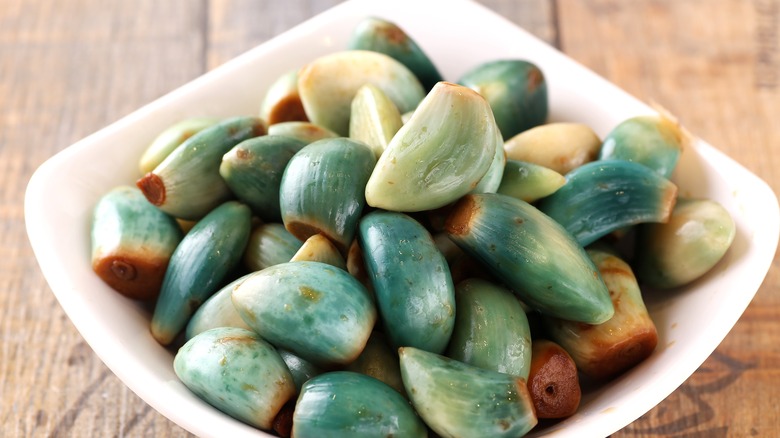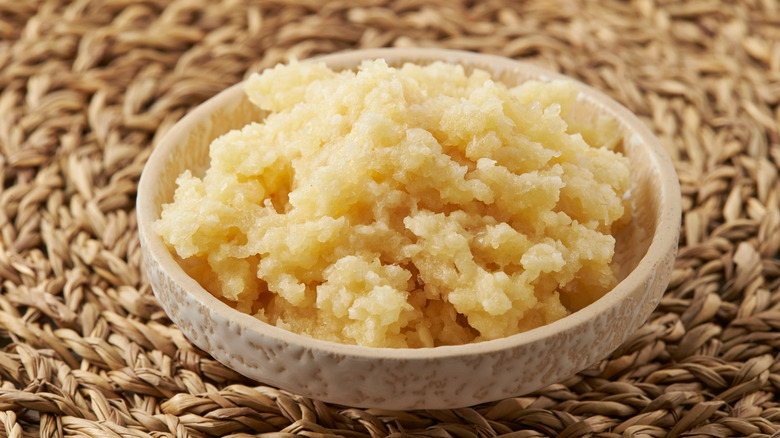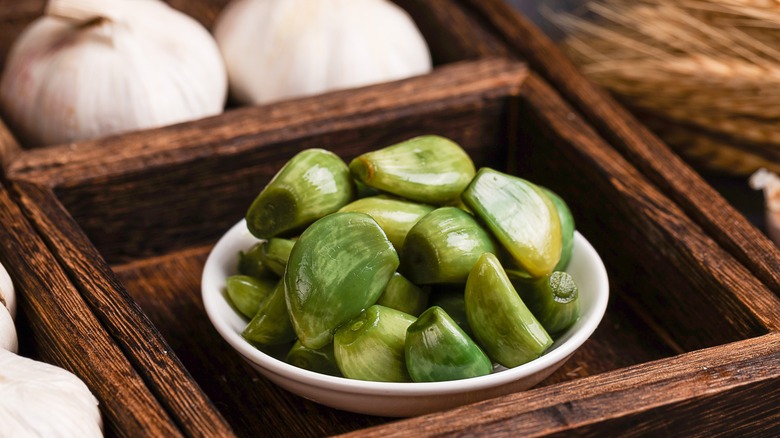Why Your Garlic Sometimes Turns Green And How To Prevent It
When you sautee garlic or just slice and save it for later, you might be shocked to find that the cloves have turned blue-green. Rest assured, that strange hue isn't caused by some kind of mold or spoilage. While the color may be off-putting, the garlic is totally safe to eat, so long as it's fresh to begin with. Still, you might want to prevent this color shift, especially if you're cooking for guests.
A combination of age and preparation can turn garlic green. There are plenty of ways to cut garlic, but all of them cause the chemicals alliin and alliinase to react with one another. These compounds remain separate if the garlic cloves are left whole, but cutting allows them to combine. This reaction creates allicin, the chemical responsible for garlic's pungent scent and flavor, as well as pyrroles: carbon-nitrogen rings that combine with each other and alter the garlic's color, depending on how many rings connect. If three connect, the garlic turns blue, while four will make it look more green.
Not all garlic turns green, of course. The older the garlic gets, the more time it has to build up extra alliin and alliinase. As the bulb ages and loses moisture, these chemicals concentrate, leading to both a stronger flavor and a proclivity to change shades. To prevent the change, try to grab a younger, fresher bulb from the grocery store. However, factors beyond age can accelerate a change in color.
How to stop garlic from turning green
Aside from using fresh bulbs, there are a few ways to prevent a color change in garlic. Firstly, keep it out of contact with acidic ingredients until the last second. Alliin and alliinase easily react with amino and acetic acids to cause a color change, and these acids give many common ingredients their sour bite. When you toss garlic with vinegar in a marinade or squeeze lemon juice into a homemade aioli recipe, it can create green or blue hues. The longer garlic sits in acid, the more likely (and quickly) it is to turn green.
If you need to add acid to a recipe earlier on, pre-cooking garlic can deactivate some of its compounds. Before you turn up the heat, keep garlic cold in the fridge to protect it from discoloration. The reaction between alliin and alliinase often happens when garlic is exposed to heat, so keeping it cool can delay the process. Don't shy away from heat, though – low and slow cooking can easily cause a color change, due to the extended exposure to heat. Use high heat when cooking old garlic, and try to keep it brief.
You can also blanch garlic by boiling it for a short time to ward off color changes, even if you then toss it with acidic ingredients. All of these methods can be extra useful if you prefer a milder garlic flavor, too, since a change in color signifies a change in taste.
Color changes impact garlic flavor, too
Garlic that turns green during cooking will usually take on a more intense taste and aroma. The more allicin is released, the more pungent the scent and flavor, and green or blue garlic is a sign of a lot of allicin at work. If you don't want the garlic to be the main star of your dish, you'll want to stick to fresh bulbs, and maybe use a few of our tips to prevent allicin overload. However, if you're just cooking for yourself and enjoy an assertive garlic flavor, the green-blue hue might not be a dealbreaker for your dinner. In fact, some cultures enjoy and celebrate green garlic.
For example, Laba garlic is a traditional northern Chinese preparation in which whole cloves are pickled until they turn green. This dish is enjoyed during the Laba festival, on the eighth day of the last month of the lunar calendar. The process begins by pickling garlic cloves in rice vinegar, and the mix is then aged to alter the coloration. Once the garlic takes on a green hue, the process is complete. Pickling turns the garlic's flavor more sour and pungent. It can be eaten on its own or stuffed into dumplings, and is sure to accompany Laba rice porridge with beans, fruits, and nuts, the most famous staple of the holiday.



